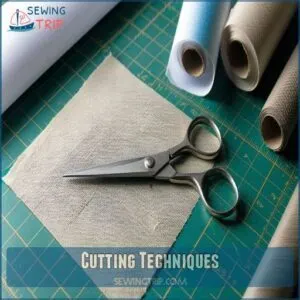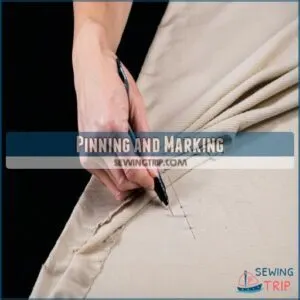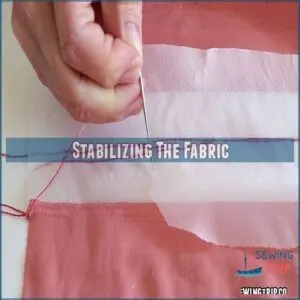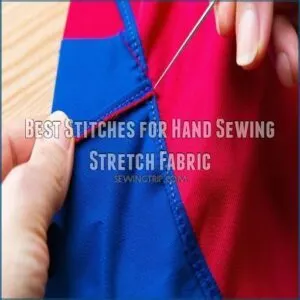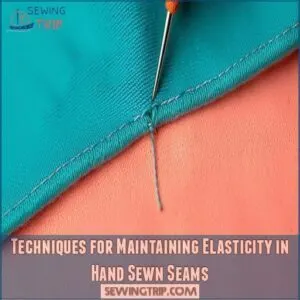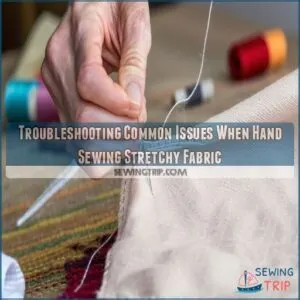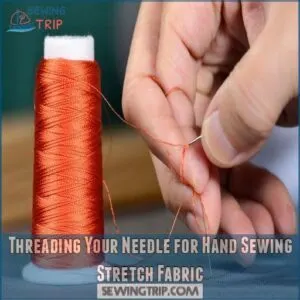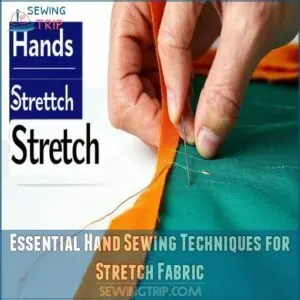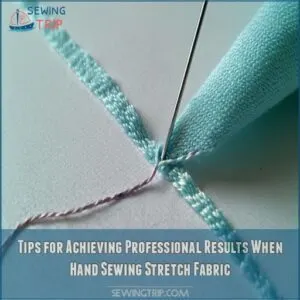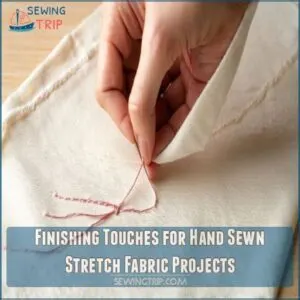This site is supported by our readers. We may earn a commission, at no cost to you, if you purchase through links.
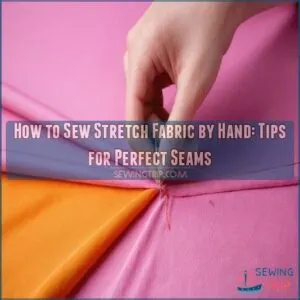 Sewing stretch fabric by hand isn’t just about stitching—it’s about mastering a fabric that has a mind of its own!
Sewing stretch fabric by hand isn’t just about stitching—it’s about mastering a fabric that has a mind of its own!
Start by picking a ballpoint needle and polyester thread; they’ll glide through like a knife through butter without snapping.
Opt for a zigzag or stretch stitch to keep everything flexible.
Always pin your fabric securely and resist tugging, treating it more like coaxing a cat off a couch with treats.
Keep your seam relaxed, and congratulate yourself on avoiding puckering.
Got wavy seams? No worries, a gentle zigzag stitch can work wonders.
Ready to stitch with confidence and finesse? There’s more to uncover!
Table Of Contents
- Key Takeaways
- Choosing The Right Tools for Hand Sewing
- How to Hand Sew Stretch Fabric Successfully
- Preparing Your Stretch Fabric for Hand Sewing
- Best Stitches for Hand Sewing Stretch Fabric
- Techniques for Maintaining Elasticity in Hand Sewn Seams
- Troubleshooting Common Issues When Hand Sewing Stretchy Fabric
- Threading Your Needle for Hand Sewing Stretch Fabric
- Essential Hand Sewing Techniques for Stretch Fabric
- Tips for Achieving Professional Results When Hand Sewing Stretch Fabric
- Finishing Touches for Hand Sewn Stretch Fabric Projects
- Frequently Asked Questions (FAQs)
- Conclusion
Key Takeaways
- Use a ballpoint needle and polyester thread to smoothly sew through stretch fabric without snags.
- Opt for zigzag or stretch stitches to maintain flexibility, and pin fabric securely to prevent movement.
- Control tension carefully and avoid pulling to prevent puckering and maintain elasticity.
- Pre-wash and stabilize fabric with tissue paper to ensure smooth sewing and avoid unexpected shrinkage.
Choosing The Right Tools for Hand Sewing
When you’re hand sewing stretch fabric, selecting the right tools can be a game changer, saving you from a headache and a handful of snapped threads.
A good ballpoint needle and stretchy polyester thread are essential companions for this journey, ensuring smooth seams that don’t unravel.
Selecting The Right Needle
When hand sewing stretch fabric, picking the right needle might feel like choosing the perfect dance partner.
A ballpoint needle, like your go-to friend at parties, slides effortlessly without snagging.
Opt for sizes 70/10 to 90/14 based on fabric thickness.
Popular brands like Schmetz or Singer offer reliable options to match your fabric’s elasticity.
Choosing The Right Thread
Choosing the right thread is as important as picking the right needle.
Polyester thread—it stretches with your fabric like a trusty sidekick.
Avoid cotton; it’s prone to snapping under pressure.
Match thread color to fabric for a seamless look.
For extra elasticity, try using stretch stitches with your chosen thread type for those perfect seams.
Additional Helpful Tools
Now that you’ve picked the perfect thread, let’s talk tools!
Grab some sharp fabric shears for clean cuts.
A seam ripper is your best friend for mistakes (we all make ’em!).
Tailor’s chalk helps mark patterns.
A measuring tape helps guarantee accuracy.
And don’t forget your trusty ballpoint or stretch needles—they’re key for hand sewing stretch fabric.
With these tools, you’re ready to conquer any stretchy project!
How to Hand Sew Stretch Fabric Successfully
Alright, you’ve got your toolkit ready; now let’s tackle the art of sewing stretch fabrics by hand.
This isn’t just stitching; it’s a little dance with your fabric.
To get the best results, consider using a ballpoint needle for stretchy-fabric.
Here are some hand sewing tips to keep your project smooth:
- Mind the Stretch: Avoid tugging too hard; let the fabric flow.
- Choose the Stitch: Opt for zigzag or a stretch stitch—your allies in flexibility.
- Pin it Down: Secure your fabric firmly to prevent unwanted movement.
- Seam with Care: Keep seams relaxed to maintain elasticity.
- Relax: It’s just fabric; mistakes mean you’re learning!
Harness these sewing tips to hand sew stretch fabric without losing your mind, and you’ll master those perfect seams in no time.
Preparing Your Stretch Fabric for Hand Sewing
When preparing your stretch fabric for hand sewing, start by washing and drying it according to the care instructions to avoid any surprises later.
Stabilizing the fabric to keep everything smooth and manageable is important.
Neat cutting and precise pinning are also crucial to ensure a successful project.
Washing and Drying
Preparing stretch fabric for hand sewing starts with washing it.
Prewashing prevents unexpected shrinkage later.
Use cool water and mild detergent to maintain elasticity.
Warm water might cause shrinkage, so cooler is your friend here.
After washing, air-dry or tumble-dry on low to keep the fabric intact.
Proper prep now saves headaches later with stains and sizing.
Cutting Techniques
Slice your stretch fabric with finesse by aligning its grain correctly.
Use sharp cutting tools to guarantee clean edges and prevent fraying.
Bias cuts offer extra stretch, but be mindful of pattern matching and seam allowances.
Mastering these cutting techniques gives you control over your DIY sewing project, making fabric manipulation a cinch.
Precision now means fewer headaches later!
Pinning and Marking
You’ve got your stretch fabric ready, but now what? It’s time to pin and mark your territory like a pro.
- Use fabric grain to guide your marking.
- Choose marking tools that don’t snag.
- Pin along the stretch direction to maintain shape.
- Remember the seam allowance; every inch counts.
These steps will keep your project on track and looking sharp!
Stabilizing The Fabric
Let’s chat about fabric stabilization techniques.
When hand sewing stretch fabric, avoiding puckering is key.
Use tissue paper or interfacing to keep the fabric steady.
This prevents unwanted stretching, like how a persistent gust can warp a kite in the wind.
You’ll maintain fabric tension and stretch stitch success, gaining control over those stretchy seams effortlessly.
Best Stitches for Hand Sewing Stretch Fabric
You’ll discover that certain stitches work better than others when hand-sewing stretchy fabrics.
We’ll explore the best options—like the trusty backstitch and the flexible zigzag—to make sure your seams stretch and move with your project, not against it!
Backstitch
Got a stretch fabric project? The backstitch is your trusty friend! It’s strong and offers flexibility when you’re hand sewing stretchy materials. Here’s why it rocks:
- Durability: Great for seams that need strength.
- Flexibility: Allows some movement with the fabric.
- Stitch Consistency: Offers uniform stitch lines.
- Alternatives: Handy if zigzag isn’t your style.
Herringbone Stitch
Dipping into hand sewing stretch fabric, the herringbone stitch might just be your secret weapon.
This stitch works wonders, offering flexibility thanks to its crisscross pattern.
Play around with herringbone stitch variations: adjust stitch length for better stretch fabric compatibility.
Keep density balanced to maintain elasticity without sacrificing durability.
It’s a classic move for securing tricky seams!
Stretch Stitch
After mastering the herringbone stitch, it’s time to experiment with stretch stitch variations.
These stitches might seem tricky, but they’re clutch for maintaining fabric elasticity.
Make sure you’re adjusting your stitch tension and length to prevent problems.
With practice, you’ll find the right hand stitch type that suits your fabric.
Keep tension even for smooth, professional seams.
Zigzag Stitch
Ready to keep your seams stretchy? Zigzag stitches are where it’s at.
This stitch lets your stretch fabric move freely, avoiding that dreaded bunch-up.
Adjust zigzag stitch length and width for best durability and stability. It’s like giving your fabric a little wiggle room.
Pair with the right sewing needles for stitch perfection, and you’re golden!
Techniques for Maintaining Elasticity in Hand Sewn Seams
Keeping your seams stretchy while hand sewing takes a bit of practice, but it’s essential for a snug fit without popping stitches.
Proper tension control, avoiding overstretching, and using elastic thread will help you maintain that perfect elasticity every time.
Proper Tension Control
Nailing those perfect seams with stretch fabric? Tension control’s your unsung hero. Balance is key—keep things snug, without wrestling the fabric.
Here’s what to do:
- Use the right needle: Ballpoint for gentle weaving.
- Opt for polyester thread: It stretches with your fabric.
- Adjust stitch length: A bit longer prevents puckering.
Get this right, and you’re golden!
Avoiding Overstretching
Because overstretching ruins your handiwork, take it easy when working with stretch fabric, especially when using a stretch needle.
Maintain even tension on your thread; don’t pull too hard.
Think of it like a delicate dance—gentle pressure keeps those stretch stitches happy.
Consistent stitch length, combined with proper tension control and fabric stabilization, prevents puckering.
A little patience goes a long way with stretch fabric.
Remember your seam allowance!
Using Elastic Thread
After handling stretch without overstretching, it’s a game-changer to try elastic thread.
This thread’s elasticity pairs perfectly with stretch fabric, letting seams move naturally.
Choose the right elastic thread types to match your fabric’s stretchiness and durability.
Adjust thread tension carefully for hand sewing, creating resilient, flex-friendly seams.
So, with elastic thread, sew like a pro!
Troubleshooting Common Issues When Hand Sewing Stretchy Fabric
Hand sewing stretchy fabric can be a bit like trying to keep a cat off the couch—tricky, yet not impossible.
If you’re encountering puckering seams, stretched garments, or those wavy seam ripples, we’ll guide you through quick fixes to ease your sewing frustrations.
Puckering or Uneven Seams
When you’re battling puckering or uneven seams, remember it’s all about tension control and stitch length.
Keep your seam allowance steady and consider the fabric type.
Use the right needle size and stretch stitches like zigzag or catch stitch.
If seams still pucker, relax the tension a bit.
Patience and practice will get you smooth, even seams.
Stretching Seams or Distorted Garments
Wavy seams got you puzzled? It likely starts with how you handle tension and your fabric choice.
Keep a watchful eye on seam allowance and don’t stretch the fabric as you sew—that’s asking for distortion.
A gentle pressing technique can work wonders, helping your garment fit better while keeping those pesky tension issues at bay.
Remember, patience is key!
Dealing With Wavy Seams
Tackling wavy seams can feel like you’re wrestling a squirmy noodle.
To master it, make sure your seam allowance is consistent and your tension control is spot-on.
Using a stretch fabric needle from a reliable supplier like Stretch Fabric Needles can also help.
Here’s how you smooth things out:
- Choose the right fabric and stitch carefully.
- Press often with gentle techniques.
- Use a zigzag stitch to prevent puckering.
- Finish seams neatly.
Stay confident!
Threading Your Needle for Hand Sewing Stretch Fabric
Threading your needle for hand sewing stretch fabric might sound simple, but it can make a world of difference in your sewing experience.
Use a needle threader to avoid frustration, and choose the right technique to secure the thread and prevent those pesky tangles.
Using a Needle Threader
Ever wrestled with a tiny needle eye?
A needle threader‘s your secret weapon!
These handy tools—from simple loops to more complex devices—make threading sewing needles a breeze.
To enhance your threading experience, consider applying some needle threading tricks like placing a white piece of paper behind the needle for better contrast.
Choose a needle threader that suits your needs and dexterity.
Insert the threader into the eye, pull it through, and then thread your needle.
It’s that easy!
You’ll save time and focus on your hand stitching and stretch fabric projects.
Mastering this simple tool opens up a world of possibilities in hand sewing!
Preventing Thread Tangles
Thread tangles can turn a sewing session into a tangled mess.
Keep your thread tension smooth by using thread quality like polyester, which glides easily.
You can find high-quality polyester thread options at a reliable thread store.
When needle threading, avoid pulling too quickly, which can twist and knot.
Store your thread in a dry spot, untangled and ready.
A little care, and you’ll sew stretch fabric with ease!
Securing The Thread
Securing your thread’s like tying a bow on a sweet gift. Here’s how:
- Thread knot: Start with a secure knot at one end.
- Thread ends: Trim excess to avoid tangles.
- Securing stitch: Use a backstitch or catch stitch at the start.
- Preventing fraying: Finishing with hand basting makes for strong, neat seams on stretch fabric.
Essential Hand Sewing Techniques for Stretch Fabric
Mastering hand sewing techniques for stretch fabric can feel like trying to tame a squirrel with a sugar rush, but with practice, you’ll soon sew like a pro.
Focus on using backstitch and stretch stitches for strong and flexible seams, and don’t forget a proper finish to keep everything neat and tidy.
The Backstitch Technique
Nail the backstitch to master seamless hand stitching.
This timeless method packs punch and flexibility for stretch fabric.
Think of it as the backbone of your sewing toolkit.
It’s not speedy, but the strength it provides guarantees your seams won’t unravel.
| Task | Focus |
|---|---|
| Backstitch | Strength |
| Variations | Flexibility |
| Alternatives | Creativity |
| History | Timelessness |
| Speed | Moderate |
Using Stretch Stitches
To master using stretch stitches, focus on flexibility and precision.
Stretch stitch types like the zigzag stitch are your best friends for hand sewing stretch fabrics.
They let the fabric move and groove without losing shape.
Use ballpoint needles—they’re like dancers, smooth on the fabric, avoiding snags.
Remember, variations exist, so find the best stretch stitch techniques for your project!
Hand Basting
Hand basting is like the rehearsal before the big show.
When dealing with stretch fabric, it works wonders by temporarily holding pieces in place, making sure everything’s on point before committing.
You can try a simple running stitch or go for longer basting stitches.
It’s a bit like using training wheels to make sure your seams stay aligned and smooth.
Finishing Seams
Because unfinished seams unravel, finishing them is key.
To prevent fraying and add strength, you should use techniques like those for finishing seams without a serger.
Here’s how to keep those stretchy edges neat:
- Use a zigzag stitch to prevent fraying.
- Consider finish raw edges of fabric without a serger for a professional look.
- A catch stitch works wonders for hemming.
These seam finishes keep your hand-sewn stretch fabric looking amazing!
Tips for Achieving Professional Results When Hand Sewing Stretch Fabric
Achieving professional results when hand sewing stretch fabric isn’t as tricky as you might think if you keep a few key tips in mind.
By maintaining even tension, using the right needle and thread, and preventing fabric distortion, you can create seams that are strong and also look like they were done by a pro.
Maintaining Even Tension
Feeling like your stitches have minds of their own? It’s all about maintaining even tension when hand sewing stretch fabric. Keep a steady hand and mind these tips:
| Tip | Description | Benefit |
|---|---|---|
| Use Stretch Needles | Rounded tips glide through fabric | Prevents snags |
| Check Tension | Keep thread neither too tight nor loose | Makes sure seams are smooth |
| Adjust Stitch Length | Longer stitches offer more give | Allows fabric to stretch easily |
| Relax Grip | Firm, but gentle hold | Avoids fabric distortion |
Find the sweet spot, and your seams will thank you!
Using The Right Needle and Thread
When sewing stretch fabrics like knit or spandex, picking the right needle and thread is really important.
Ballpoint or stretch needles glide through fabric without snagging.
For a suitable thread, consider shopping for polyester sewing thread to make sure you have the right type for your project.
Opt for polyester thread for its stretchiness and durability over cotton thread, which can easily snap.
Match thread color to fabric for a seamless look, making sure you get professional results with minimal hassle.
Preventing Fabric Distortion
Stretch fabrics can be sneaky, distorting with a tiny pull or misstep.
Avoid puckering by following these tips:
- Fabric Stabilization: Use tearaway stabilizers or tissue paper to keep your material steady.
- Tension Control: Keep thread tension even to skirt unwanted bunches.
- Pressing Techniques: Gently press seams with a low-heat iron for a smooth finish.
Finishing Touches for Hand Sewn Stretch Fabric Projects
As you wrap up your hand-sewn stretch fabric project, focus on hemming to keep everything tidy and secure.
Don’t forget to reinforce high-stress areas and add some fun embellishments for that final flair!
Hemming Stretch Fabric
Got those seams looking sharp? Now, let’s talk about hemming stretch fabric so it stays smooth and bunch-free.
Use a zigzag or stretch stitch for flexibility.
Pin your fabric evenly and try using a stabilizer to keep it steady.
Hemming techniques can vary, so here’s a quick guide:
| Technique | Fabric Type | Stitch | Stability Trick |
|---|---|---|---|
| Zigzag Stitch | Jersey | Elastic thread | Use tearaway |
| Blind Hem | Knit | Polyester | Tissue paper |
| Double Needle | Spandex | Stretch | Fusible tape |
| Overlock | Fleece | Nylon | Temporary spray |
Reinforcing High-Stress Areas
After neatly hemming those edges, let’s talk reinforcement.
To really make sure the seams on your stretchy fabric hold up, consider using a technique like sewing with the aid of tissue paper stabilization.
High-stress areas like seams on your stretch fabric need extra love.
A simple backstitch along the seam line adds serious durability.
For added strength, use a catch stitch to secure the seam allowance.
These small steps prevent those pesky rips and tears, keeping your handmade masterpiece looking fabulous.
Remember, a little extra care goes a long way!
Adding Embellishments
Adding embellishments to stretch fabrics like spandex or knit can be tricky.
Try embroidery techniques or applique ideas to jazz up your project.
Beading options and fabric paint add sparkle without weighing down the fabric.
Sewing buttons provides a chic touch.
Just keep it light so the fabric’s natural stretch isn’t compromised.
Think creatively, and enjoy the process!
Frequently Asked Questions (FAQs)
How to sew stretch fabric by hand?
Start with a ballpoint needle and polyester thread.
Use zigzag stitches to maintain flexibility.
Keep tension light and stitch in the fabric’s direction.
Stabilize with tissue paper for smoother sewing.
Wash and dry fabric before starting.
How do you sew stretchy fabrics?
Sewing stretchy fabrics can feel like wrestling a slippery fish, but with a ballpoint needle and polyester thread, you’ll glide through it.
Zigzag stitches are the best choice for stretchy fabrics.
Match your stitch direction with the fabric stretch for best results.
How do you use a hand stretch stitch?
To use a hand stretch stitch, grab a ballpoint needle and polyester thread.
Pull gently, leaving slack on the bottom thread, and tighten the top.
Maintain even tension to keep the fabric’s elasticity and prevent puckering.
Can you sew stretchy fabric with a sewing machine?
Remember that time you wrestled with a stubborn zipper?
Yeah, stretchy fabric‘s a bit like that.
You absolutely can sew it with a machine,
but you’ll need the right tools—a ballpoint needle and stretchy thread are your best friends!
What hand stitches work with stretchy fabrics?
You should try using a zigzag stitch or backstitch for sewing stretchy fabrics by hand.
These stitches offer flexibility and strength, letting the fabric move without breaking the seam.
Use ballpoint needles to avoid fabric damage.
How do you HEMM a stretch fabric?
Hem stretch fabric by using a zigzag stitch in the fabric’s stretch direction.
Use a ballpoint needle and polyester thread for flexibility.
Stabilize with tissue paper and avoid pulling the fabric to prevent distortion and puckering.
What is the best stitch for stretchy fabric by hand?
Did you know that 90% of hand-sewn seams in stretchy fabric fail due to improper stitching?
Zigzag stitch is the hero you need.
This stitch moves with the fabric, preventing puckering while keeping seams stretchy and durable.
Is there a trick to sewing stretchy fabric?
Using ballpoint needles and polyester thread helps avoid common pitfalls.
Stabilize the fabric with tissue paper to prevent stretching.
Adjust stitch length and tension balance for elasticity.
Pre-wash to prevent shrinkage; sew along stretch direction.
How do you sew elastic on stretchy fabric by hand?
Imagine attaching elastic to your favorite stretchy shirt.
Use a ballpoint needle and polyester thread.
Hand stitch with a zigzag pattern, stretching the elastic slightly.
Keep stitches loose, ensuring the fabric’s elasticity remains intact.
Can you sew stretch fabric with a normal needle?
You can sew stretch fabric with a normal needle, but it’s tricky.
Using a ballpoint needle helps avoid snags, making your job a breeze.
Without it, expect popped stitches and frustration.
Better tools mean smoother sewing!
Conclusion
So, you’ve conquered the beast—stretchy fabric!
Remember, mastering how to sew stretch fabric by hand takes practice, but you’ve got this.
Those perfect seams? They’re within your reach.
Keep your needles sharp, your thread strong, and your patience high.
Don’t be afraid to experiment with different stitches and techniques; find what works best for you and your projects.
Happy sewing! Now go forth and create amazing things!



